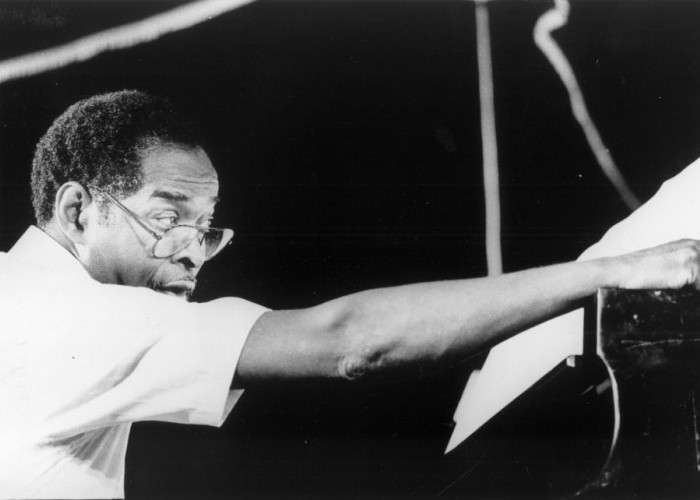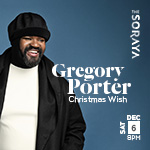Oct 28, 2025 10:47 AM
In Memoriam: Jack DeJohnette, 1942–2025
Jack DeJohnette, a bold and resourceful drummer and NEA Jazz Master who forged a unique vocabulary on the kit over his…

A Jan. 29 memorial service in New York for Muhal Richard Abrams opened with the performance of his recently composed chamber work, “Trio Things,” by pianist Joe Kubera, violinist Tom Chiu and cellist Meaghan Burke.
(Photo: Elena Carminati/DownBeat Archive)Family, friends and fellow creative artists gathered at The Community Church of New York on Jan. 29, for “A Musical Tribute To Dr. Muhal Richard Abrams,” who died three months earlier on Oct. 29, at the age of 87.
The memorial for the NEA Jazz Master, cofounder and first president of the Association for the Advancement of Creative Musicians began with Pat Cruz elucidating on the pioneering principles of spiritual awareness, freedom and self determination that have served as the collective’s guiding philosophy for more than 50 years.
The musical portion of the semi-private event began appropriately with the performance of Abrams’ recently composed chamber work, “Trio Things,” by pianist Joe Kubera, violinist Tom Chiu and cellist Meaghan Burke that demonstrated the breadth of his compositional skill. New Music baritone vocalist Tom Buckner, the first of Abrams’ many collaborators to offer remarks, lauded the late pianist/composer, noting that “what Muhal has inspired will blossom and flower.”
He was followed by a performance featuring pianist Randy Weston and flutist T. K. Blue, who performed a stirring rendition of Weston’s “The Healer.”
Then, one by one, Henry Threadgill, Roscoe Mitchell, Tania León and Leonard E. Jones came forward to speak, offering remembrances of their first meetings with Abrams and the years of inspiration that followed. Standing before the stage, flanked on either side by a smiling portrait of their friend and mentor, they spoke of Abrams’ wisdom and generosity of spirit, as well as his embrace of each one as family. Seth Rosner and Yulun Wang, of Pi Recordings, reflected on the powerful influence of Abrams’ philosophy, as well as AACM’s, in the founding and direction of their endeavor. Anthony Braxton praised Abrams for his “insight, discipline and stamina,” observing that his vision proved to be “a blueprint for the future that is still relevant today … keeping the flame of creativity alive.”
“Hooray for my teacher,” he concluded.
Cruz’s reading of similarly admiring statements from Douglas Ewart, Frank Gordon, Alvin Fielder and Chico Freeman was followed by a video of Steve Coleman in which he described Abrams as a “font of knowledge … who helped make this music what it is because he touched so many other people.” Bassist Rufus Reid spoke of his years with Abrams in Eddie Harris’ band, describing his rhythm-section partner as “focused, consistent and giving; a born teacher who practiced what he preached.” He was then joined on stage by drummer Andrew Cyrille. The pair played a mesmerizing duet, “Muhal,” that began with a virtuoso bass recital and was followed by a series of bass and drum exchanges, during which Cyrille prefaced each segment by chanting the letters “M-U-H-A-L.”
Oliver Lake recited his rhythmic poem “Ain’t Nuthin’ Real But Love” that ended with the line “Muhal is love.” Then the trio of alto saxophonist Marty Ehrlich, bassist Brad Jones and cellist Tomeka Reid played a medley of two Abrams’ compositions that began with “Bump’s Ballad” and concluded with “Charlie In The Parker,” a tour de force outing that Ehrlich played while a member of Abrams’ band. The music continued with trombonist Craig Harris’ quintet, featuring saxophonist Jay Rodriguez, pianist Adam Klipple, bassist Calvin Jones and drummer Tony Lewis performing “Big 23” from his Brown Butterfly Suite, followed by a solo drum and gong recital by Reggie Nicholson.
Vijay Iyer and Wadada Leo Smith played an emotional rendition of the former’s “Marian Anderson” that was rife with impressionistic beauty, before the trio of Roscoe Mitchell, George Lewis and Jack DeJohnette improvised powerfully on Abrams’ tribute to Johnny Griffin, “JG,” at times recalling the sound of the Art Ensemble of Chicago. Iqua and Adegoke Steve Colson, with violinist Marlene Rice, bassist Santi Debriano and Nicholson rendered a moving narrative work, “The Road.” Then Threadgill, joined by the latter Colson on piano, Amina Claudine Myers on organ and George Lewis, played his “Sail,” an airy outing that featured the warm sound of the bass flute.
Regrettably, due to the venue’s curfew, the ceremony was forced to end before Anthony Braxton’s scheduled performance with Taylor Ho Bynum and Carl Testa could take place. Still, spirits remained high as the crowd exited, accompanied by Myers’ church organ processional. DB

Jack DeJohnette boasted a musical resume that was as long as it was fearsome.
Oct 28, 2025 10:47 AM
Jack DeJohnette, a bold and resourceful drummer and NEA Jazz Master who forged a unique vocabulary on the kit over his…

D’Angelo achieved commercial and critical success experimenting with a fusion of jazz, funk, soul, R&B and hip-hop.
Oct 14, 2025 1:47 PM
D’Angelo, a Grammy-winning R&B and neo-soul singer, guitarist and pianist who exerted a profound influence on 21st…

To see the complete list of nominations for the 2026 Grammy Awards, go to grammy.com.
Nov 11, 2025 12:35 PM
The nominations for the 2026 Grammy Awards are in, with plenty to smile about for the worlds of jazz, blues and beyond.…

Jim McNeely’s singular body of work had a profound and lasting influence on many of today’s top jazz composers in the U.S. and in Europe.
Oct 7, 2025 3:40 PM
Pianist Jim McNeely, one of the most distinguished large ensemble jazz composers of his generation, died Sept. 26 at…

Drummond was cherished by generations of mainstream jazz listeners and bandleaders for his authoritative tonal presence, a defining quality of his style most apparent when he played his instrument unamplified.
Nov 4, 2025 11:39 AM
Ray Drummond, a first-call bassist who appeared on hundreds of albums as a sideman for some of the top names in jazz…






